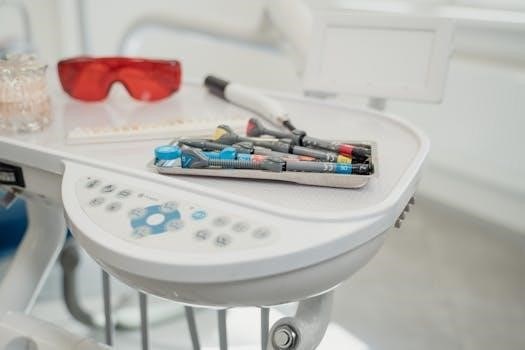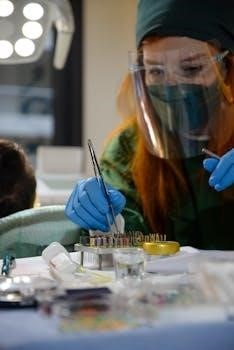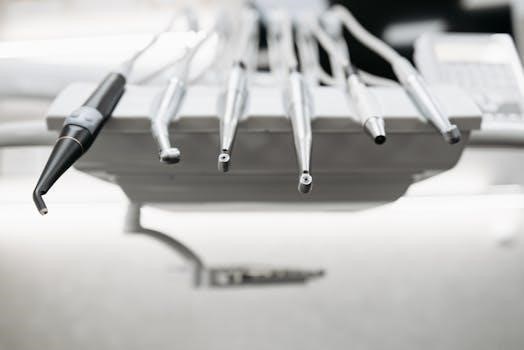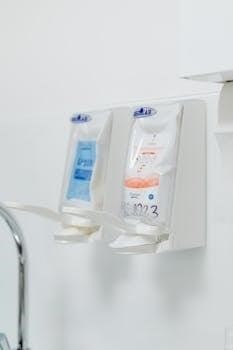
-
By:
- ophelia
- No comment
dental instruments pictures and names pdf
Dental Instruments⁚ Pictures and Names (PDF Guide)
Understanding dental instruments and their names can ease patient anxiety. This guide provides pictures and descriptions of common dental instruments and their purposes. A PDF guide with dental instruments names and pictures will give you a brief overview of these tools. Explore essential dental instruments.
Dental instruments are indispensable tools utilized by dental professionals to perform a wide array of procedures, ranging from routine examinations to intricate surgical interventions. These instruments are meticulously designed to aid in the examination, restoration, and extraction of teeth, as well as the treatment of surrounding oral structures. Familiarizing oneself with the common dental instrument names and their respective functions can significantly alleviate patient anxiety and foster a sense of preparedness when visiting the dental clinic.
This comprehensive guide aims to provide a detailed overview of various dental instruments, complete with illustrative pictures and clear descriptions of their intended purposes. The information presented herein will empower patients to better understand the tools employed during dental procedures, thereby promoting a more relaxed and informed experience. Furthermore, this resource serves as a valuable reference for dental students and aspiring dental professionals seeking to expand their knowledge of dental instrumentation.
From basic examination tools like dental mirrors and probes to more specialized surgical instruments, this guide covers a broad spectrum of dental implements. Each instrument is carefully explained, highlighting its unique features and applications within the field of dentistry; By gaining a thorough understanding of these instruments, patients can actively participate in their oral healthcare and confidently engage with their dental providers.
Basic Dental Examination Instruments
The foundation of any dental appointment lies in a thorough examination, facilitated by a core set of instruments. These basic tools enable dentists to visually inspect the oral cavity, identify potential issues, and gather crucial information for diagnosis and treatment planning. This section delves into the essential instruments used during a standard dental examination, highlighting their specific roles and features.
The fundamental examination kit typically comprises four key instruments⁚ the dental mirror, probe/explorer, and tweezers (cotton forceps). Each instrument plays a distinct role in the examination process. The dental mirror, with its reflective surface, allows the dentist to indirectly visualize areas of the mouth that are otherwise difficult to access, such as the lingual surfaces of teeth and the posterior regions of the oral cavity. Some mirrors even offer magnification for enhanced detail.
The probe, also known as an explorer, is a slender instrument with a sharp, pointed tip. It is used to detect subtle irregularities on the tooth surface, such as cavities or areas of demineralization. The explorer’s tactile sensitivity enables the dentist to assess the texture and hardness of enamel, aiding in the early detection of dental caries. Lastly, tweezers, or cotton forceps, are used to grasp and transfer small items, such as cotton pellets, into and out of the oral cavity.
Dental Mirror
The dental mirror, a seemingly simple tool, is an indispensable component of the dental examination. It’s primary function is to provide indirect vision, allowing the dentist to view areas of the mouth that are not directly visible. This is particularly crucial for examining the lingual surfaces of teeth (the surfaces facing the tongue) and the distal areas of the posterior teeth (the back teeth). Without the dental mirror, accessing and visualizing these regions would be significantly challenging.
Beyond indirect vision, the dental mirror also serves to retract soft tissues, such as the tongue and cheeks, providing a clearer field of view. By gently maneuvering the mirror, the dentist can move these tissues out of the way, improving access to the teeth and surrounding structures. This retraction capability is essential for a comprehensive examination.
Furthermore, some dental mirrors are designed with a magnifying surface. Concave mirrors provide image magnification, this enhances the dentist’s ability to identify subtle details, such as small cavities or early signs of gum disease. The enhanced visibility afforded by magnification can lead to earlier detection and more effective treatment.
In essence, the dental mirror is a versatile tool that plays a critical role in facilitating a thorough and accurate dental examination. Its ability to provide indirect vision, retract soft tissues, and, in some cases, magnify the image makes it an indispensable instrument in the dentist’s arsenal.
Probe/Explorer
The probe, also known as an explorer, is a slender, pointed instrument vital for tactile examination in dentistry. Its primary function is to detect surface irregularities on teeth, particularly identifying the presence of cavities or assessing the texture of dental restorations. The sharp tip of the probe allows the dentist to gently explore the enamel surface, feeling for subtle changes in hardness or smoothness that may indicate decay.
Explorers come in various shapes and sizes, each designed for specific purposes. Some probes feature a curved or angled tip, enabling access to difficult-to-reach areas, such as pits and fissures on the occlusal surfaces of molars. Others have a straighter design for examining smooth surfaces.
In addition to detecting cavities, the probe is also used to evaluate the integrity of existing dental work. By carefully running the probe along the margins of fillings, crowns, or sealants, the dentist can identify any gaps or rough edges that may indicate leakage or failure.
Furthermore, periodontal probes, a specialized type of explorer, are used to measure the depth of the gingival sulcus, the space between the tooth and the gum tissue. This measurement is crucial for diagnosing and monitoring periodontal disease (gum disease). The probe is inserted gently into the sulcus, and the depth is read from markings on the instrument.
Overall, the probe/explorer is an essential diagnostic tool that enables dentists to identify potential problems early, leading to more effective treatment and better oral health outcomes.
Tweezers (Cotton Forceps)
Dental tweezers, often called cotton forceps, are a fundamental instrument used in dentistry for grasping and manipulating small objects within the oral cavity. Their primary purpose is to transfer cotton pellets, gauze, or other materials to and from the mouth with precision and hygiene. The tweezer’s design typically features two slender, hinged arms that meet at a pointed or slightly rounded tip, allowing for a secure grip on delicate items.
Dentists use cotton forceps for a variety of tasks during examinations and treatments. They are essential for applying topical anesthetics, drying specific areas of the mouth, and placing or removing cotton rolls to control saliva flow. During restorative procedures, tweezers assist in positioning small items like wedges or matrices.
The tips of dental tweezers are designed to be non-traumatic to the soft tissues of the mouth. Some forceps have serrated tips for improved grip, while others have smooth tips to prevent damage to delicate materials. The handles are often ergonomically designed for comfortable and controlled handling.
Maintaining the sterility of dental tweezers is of utmost importance to prevent cross-contamination. They are typically made of stainless steel and can be easily sterilized using autoclaving or other suitable methods. Regular sterilization ensures a safe and hygienic environment for both the patient and the dental professional.
In essence, dental tweezers or cotton forceps are a simple yet indispensable tool that facilitates numerous procedures in dental practice, contributing to the efficiency and effectiveness of patient care.
Common Dental Instruments and Their Uses
Beyond the basic examination tools, a variety of specialized instruments are employed in dentistry for specific treatments and procedures. These instruments are designed to address different aspects of oral health, from cleaning and restoration to surgery and orthodontics. Each instrument has a unique purpose and is handled with precision by dental professionals to ensure optimal patient care.
Handpieces, also known as dental drills, are used to remove decay, shape teeth, and polish restorations. They come in various speeds and configurations to suit different procedures. Scalers and curettes are essential for hygiene, removing plaque and tartar from teeth and below the gumline to prevent periodontal disease. Elevators and forceps are used during extractions to loosen and remove teeth with minimal trauma.
Composite instruments are specifically designed for placing and shaping composite resin fillings, allowing dentists to create natural-looking restorations. Bone chisels and rongeurs are used in surgical procedures to reshape or remove bone tissue. Matrix bands and retainers are used to create a temporary wall around a tooth during filling procedures, ensuring proper shape and contour.

Other common instruments include spatulas for mixing dental materials, articulating paper holders to check the bite, and burs for cutting and polishing. Each instrument plays a crucial role in delivering comprehensive dental care, and dental professionals are trained to use them effectively and safely.

Understanding the function of these common dental instruments can help patients feel more informed and comfortable during their dental visits. By familiarizing themselves with the tools used, patients can better appreciate the complexity and precision involved in modern dentistry.
Instruments for Amalgam Manipulation
Amalgam, a dental filling material composed of a mixture of metals, requires specific instruments for its proper handling and placement. These instruments are designed to condense, shape, and carve the amalgam to restore a tooth to its original form and function. The correct use of these tools ensures a durable and effective restoration.
An amalgam carrier is used to transport the mixed amalgam from the mixing well to the prepared tooth cavity. It has a small, cylindrical barrel that can be filled with amalgam and then dispensed into the cavity. Amalgam condensers, also known as pluggers, are used to pack the amalgam tightly into the cavity, removing air bubbles and ensuring close adaptation to the tooth structure.
Carvers are used to shape the amalgam filling to match the natural contours of the tooth. Different carver shapes, such as discoid-cleoid and hollenback carvers, allow the dentist to create anatomical features like grooves and ridges. Burnishers are used to smooth the surface of the amalgam filling, creating a smooth, polished finish that reduces the risk of plaque accumulation.
Other instruments used in amalgam manipulation include amalgam wells for holding the mixed amalgam, and matrix bands and retainers to create a temporary wall around the tooth during the filling procedure. These instruments work together to ensure that the amalgam filling is properly placed, shaped, and finished, providing a long-lasting restoration for the patient.
Mastering the use of these amalgam manipulation instruments is essential for dental professionals to provide high-quality amalgam fillings. The proper technique and selection of instruments contribute to the success and longevity of the restoration.
Amalgam Carrier
The amalgam carrier is a vital instrument in restorative dentistry, specifically designed for the efficient and precise transportation of dental amalgam. This instrument facilitates the transfer of the mixed amalgam material from the amalgam well to the prepared tooth cavity. Its design prioritizes ease of use and controlled placement of the amalgam.
Typically constructed from stainless steel, the amalgam carrier features a hollow, cylindrical barrel with a plunger mechanism. The barrel is filled by scooping the amalgam from the mixing well. The plunger, activated by a lever or button, expels the amalgam into the prepared tooth cavity. This controlled delivery minimizes waste and ensures accurate placement.
Amalgam carriers are available in various sizes to accommodate different cavity preparations and clinical preferences. Some carriers are double-ended, with different barrel sizes on each end, offering versatility during the restorative procedure. The choice of carrier size depends on the size of the cavity and the amount of amalgam needed.

Proper technique when using the amalgam carrier involves carefully filling the barrel with amalgam, ensuring it is densely packed. The carrier tip is then positioned over the cavity, and the plunger is activated to dispense the amalgam in small increments. This incremental placement allows for proper condensation and adaptation of the amalgam to the tooth structure.

Maintaining the amalgam carrier is crucial for its longevity and functionality. After each use, the carrier should be thoroughly cleaned to remove any residual amalgam. Sterilization is essential to prevent cross-contamination; Regular inspection and maintenance ensure the amalgam carrier remains a reliable tool in the dental practice, aiding in the efficient and effective placement of amalgam restorations.
Amalgam Condenser (Plugger)
The amalgam condenser, also known as a plugger, is an essential dental instrument used in restorative dentistry for compacting dental amalgam into a prepared tooth cavity. Its primary function is to condense the amalgam, removing voids and ensuring a dense, well-adapted restoration; This process strengthens the filling and improves its longevity.
Typically made of stainless steel, the amalgam condenser features a handle and a working end, or nib, available in various shapes and sizes. Common nib shapes include round, rectangular, and diamond, each designed for specific areas and contours of the tooth. The size of the nib is chosen based on the dimensions of the cavity preparation.
The condensation process involves applying pressure to the amalgam in small increments. This forces the amalgam particles together, reducing porosity and improving the overall density of the restoration. Proper condensation is crucial for achieving optimal strength and resistance to fracture.
Dentists employ different condensation techniques, including lateral and vertical condensation. Lateral condensation involves applying pressure to the sides of the amalgam, while vertical condensation applies pressure directly to the surface. A combination of both techniques is often used to ensure thorough compaction.
Amalgam condensers are available in both hand-held and mechanical versions. Hand-held condensers require manual force, while mechanical condensers utilize a vibrating or tapping action to compact the amalgam. The choice between the two depends on the dentist’s preference and the specific requirements of the case.
Proper maintenance of amalgam condensers is essential for their functionality and longevity. After each use, the instrument should be thoroughly cleaned and sterilized to prevent contamination. Regular inspection ensures the nib remains in good condition and the instrument functions effectively, contributing to successful amalgam restorations.
Hygiene Instruments
Hygiene instruments are a crucial category of dental tools specifically designed for maintaining oral health and preventing dental diseases. These instruments are primarily used by dental hygienists during routine cleanings and preventive procedures.
One of the most common hygiene instruments is the scaler. Scalers come in various shapes and sizes, each designed to remove plaque and calculus (hardened plaque) from different tooth surfaces. Sickle scalers are used for removing supragingival calculus (above the gum line), while curettes are used for subgingival calculus (below the gum line) removal and root planing.
Another essential hygiene instrument is the periodontal probe. This instrument is used to measure the depth of periodontal pockets, which are spaces between the teeth and gums. Measuring pocket depth helps assess the severity of gum disease (periodontitis) and guides treatment planning. The probe has markings in millimeters to accurately measure the pocket depth.
Dental mirrors are also used during hygiene appointments to provide indirect vision of areas that are difficult to see directly, such as the lingual (tongue-side) surfaces of teeth. The mirror also retracts the tongue or cheek to improve visibility.
Polishing instruments, such as prophy cups and brushes, are used with a polishing paste to remove stains and smooth the tooth surfaces after scaling. This makes it more difficult for plaque to adhere to the teeth.
Air-water syringes are used to rinse and dry the teeth during the hygiene appointment, improving visibility and removing debris. Ultrasonic scalers are also commonly used to remove calculus with less pressure, making the cleaning process more comfortable for the patient. Proper sterilization of hygiene instruments is essential to prevent the spread of infection.
Surgical Instruments in Dentistry
Surgical instruments in dentistry are specialized tools used for performing various surgical procedures within the oral cavity. These procedures range from simple tooth extractions to complex implant placements and reconstructive surgeries. Sterilization is paramount for all surgical instruments to prevent infection.
Forceps are used to extract teeth. They come in different shapes and sizes, designed to grip specific teeth effectively. Elevators are used to loosen teeth from their sockets before extraction with forceps. Periosteal elevators are used to reflect the periosteum (the membrane covering the bone) to gain access to the underlying bone.
Bone chisels and osteotomes are used to reshape or remove bone. Rongeurs are used to remove sharp or unwanted bone fragments. Surgical curettes are used to clean out sockets or remove diseased tissue.
Scalpels with disposable blades are used for making incisions in the soft tissues. Retractors are used to hold back tissues, providing better visibility of the surgical site. Needle holders are used to grasp and manipulate needles when suturing tissues together.
Surgical burs are used with dental handpieces to cut or shape bone. Suture materials are used to close incisions. Bone grafting instruments are used to place bone graft materials in areas where bone is missing.
Implant instruments are used specifically for implant placement, including drills, drivers, and torque wrenches. Proper training and skill are essential for using these instruments effectively and safely. Many surgical instruments are multifunctional, referred to by more than one name depending on the specific technique. Understanding the names and functions of these instruments is critical for dental professionals performing surgical procedures.